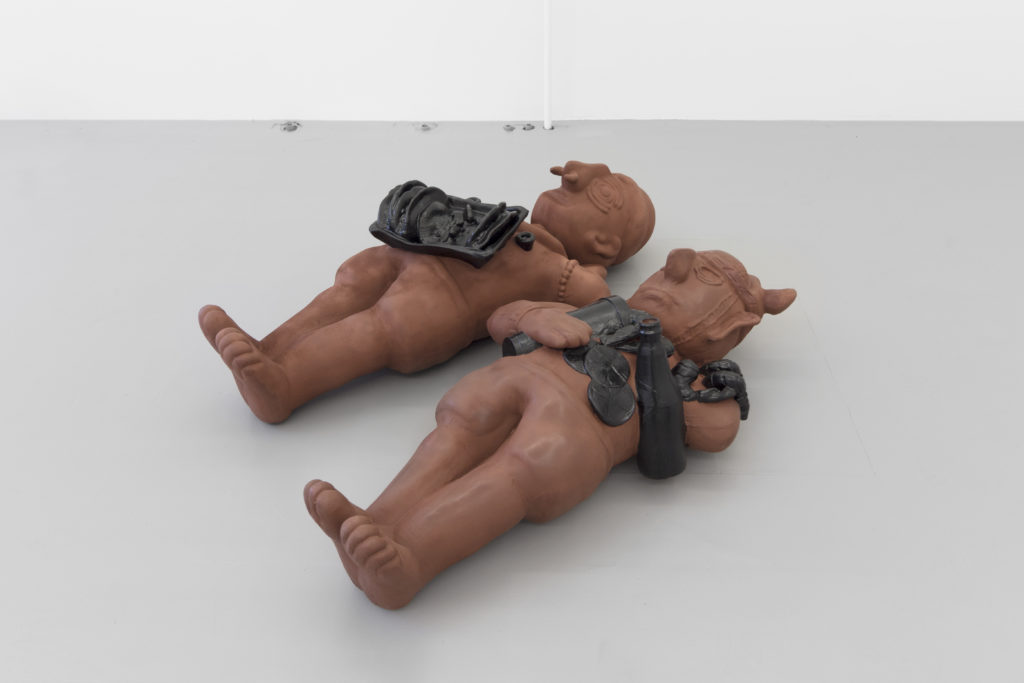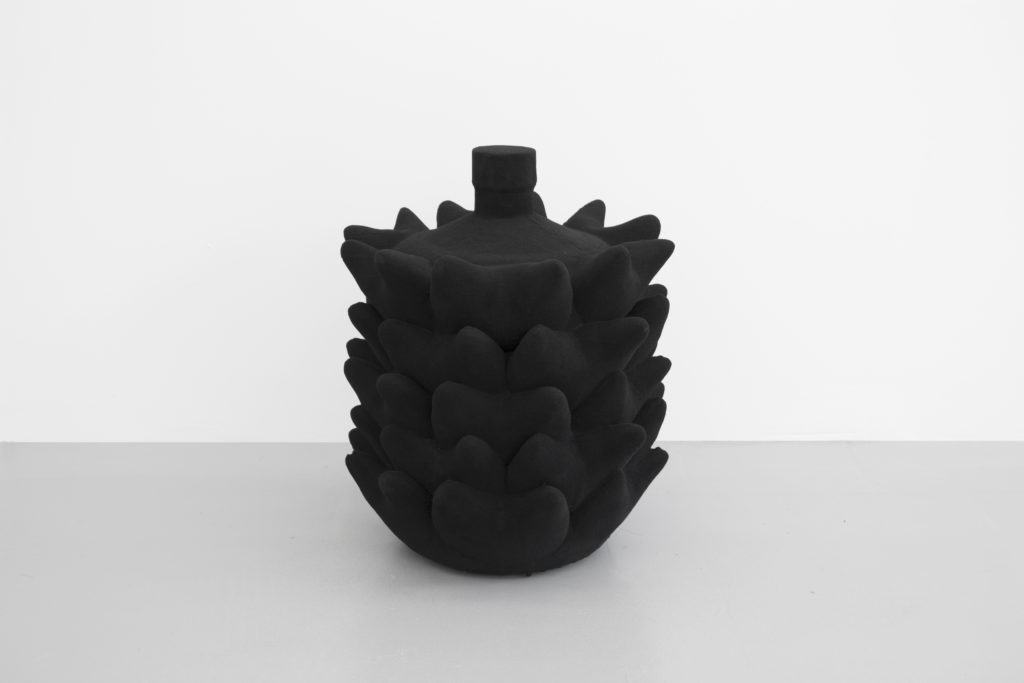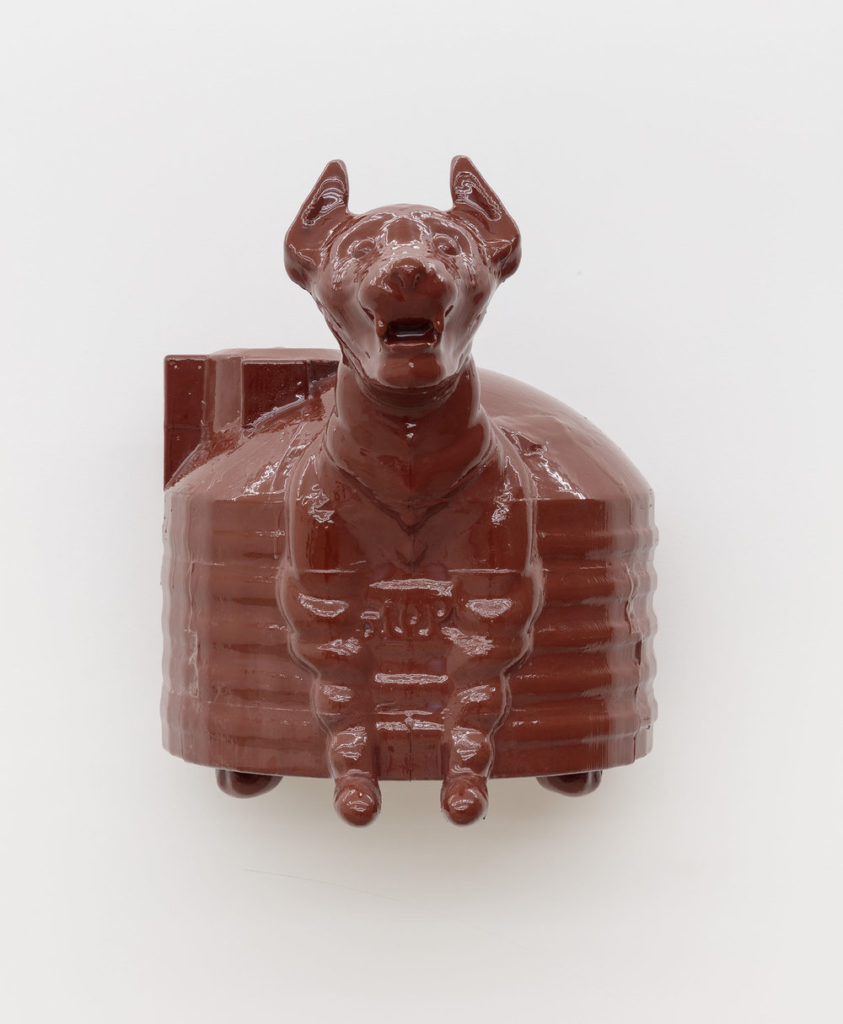In Conversation: An Interview with André Filipek-Magaña
by Celia Glastris

Sourcing both material and subject from his axis-point in a giant globalizing narrative, Brooklyn-based artist André Filipek-Magaña challenges ways of seeing. His solo exhibition, titled Reclinados, was recently showcased at Prairie Gallery in the Pilsen neighborhood of Chicago this summer. The show featured sculptures that derived their visual language from West Mexico’s Colima ceramics, originally produced between 300 BCE to 500 CE. The full, mysterious effect of Reclinados was not immediate. What first engaged the viewer were layers of cultural and political context— contemporary Mexican ceramics informed by pre-Columbian craft splay across the ground with a disregard for the museum-historical narrative in an American gallery. The work provoked expectations that Filipek-Magaña ultimately, playfully redirected.
Lying on their backs and adorned with nose rings, helmets, and horns, the mise-en-scene looked like the aftermath of an act of violence, either situated in a contemporary or pre-Columbian timeline. Upon closer inspection, however, these Mesoamerican ballplayers were leisurely enjoying Mexican comfort food such as elotes, tacos, and conchas. The misevaluation was unsettling and confronted a preconceived expectation for Mexican art to depict brutality. Frankly, any iteration of Reclinados would have been political, just as virtually any form of presenting pre-colonial art will return with controversial undertones—even if the subjects are casually enjoying a day off.
Upon further observation, Filipek-Magaña’s sculptures, which appear to be ceramic, are in actuality 3D-printed out of thermoplastic. While listed in the materials on the checklist, this detail was decisively excluded from press releases. It was a surprising and curious omission, as extensive discourse on the rising trend of 3D-scanned archives of museum collections feeds a plethora of artistic practices. Furthermore, perhaps this new fabrication method offers a way to contemporize Colima ceramics. The artist however, told me he is not interested in using 3D models from museums and also clarified that the latter association unveils an institutionally engrained belief of indigenous art as in the past. It also unveils a bias toward technology. During the interview Filipek-Magaña, who is employed by a 3D printing company, explained that the most so-called ‘contemporizing’ component of the 3D printer for his art stems from the necessity to work for the tech industry in order to support his practice and afford living in New York City.
While artists have been using 3D printing without feeling a need to contextualize the novel medium for some time now, most who use it and also work with pre-colonial or archaeological themes emphasize their production. Not only does Filipek-Magaña mark the classic shift away from making about a novel emerging media to its natural integration as an artistic tool, but the artist is also thoroughly situated within its politically charged matrix as a Mexican-American employee of an industry he believes to be “a covert form of colonialism.” Just as the casual floor install renounces colonialist innuendos of a sterile, glass museum display, de-sensationalizing the 3D printer marks a migration away from a techno-fetishized ideology that undermines the value of human labor. While Filipek-Magaña’s characters enjoy their break, the viewer’s eyes work to untangle the web of lighthearted cultural connotations within the scene that demonstrate the tiresome identity politics of the era’s social and technological environment.
Celia Glastris: Tell me about your work, your “artist statement.”
André Filipek-Magaña: I primarily utilize 3D Printing to construct sculptures that interpret pre-colonial Western Mexican craft languages, through a Mexican-American and post-Industrial lens. Working within a regional discipline from my own family history acts as a tool for personal decolonization. Using the framework of a pre-colonial art history, I am able to reference topics like water access, racial stereotypes, assimilation, and demonstrate the ways that colonialism is embedded in daily life.
I am interested in how using 3D Printing and CAD technology to make what would be considered ‘folk art’ can destabilize technology-progressive, innovation-centered ideology. I imagine my work existing in a possible near future after the collapse of globalism, where 3D modeling and plastics are more available than traditional craft materials.

CG: You recently exhibited at Prairie Gallery. What are the works in this? Or, what were you communicating?
AFM: The focus of Reclinados was to really think through the purpose of Colima ceramics as a mode of societal documentation. The figures are based on various ‘warrior’ figures known in archaeological research as ‘ballplayers.’
The ballplayers are social pawns that engaged in sport as a means of settling civil disputes. They acted as warriors in scenarios where the ‘ball games’ would fail to fulfill its purpose. In some ways I see them as decorated sacrificial lambs not unlike any military. The upshot here is that their nature as figures predating colonial intervention in Mexico allows me to frame them as a proxy for Mexican people, perhaps immigrants to the United States, who occupy a similar space in relationship to power structures of neo-colonialism, white supremacy, and Western hegemony.
I wanted to set up the exhibition in such a way that straddles both the aftermath of a battle scene and a picnic. When walked through, the viewer sees that the figures are relaxing and enjoying comfort foods perched on their bellies, whereas the wide view of the exhibition shows stiff figures strewn about the gallery floor. I like the idea that these figures are taking a break from work and enjoying a moment of solitude and simple pleasure.
CG: How have you developed your characters for Reclinados? Does it look like scholarly research, visiting museums, or finding works in gift shops?
AFM: I do all of this. These figures are pretty deeply embedded into the visual language of the city and state of Colima in Western Mexico. There is a large craft culture. Aside from ceramics, stone carving and jewelry made from volcanic rocks of the Colima volcano are prevalent. I am always interested in what Colima works are in the museum’s collection, so I try to visit when I am in a new place. They are everywhere! Most of the time, I look at digital museum collection archives. There are a ton of gift shops in Colima—if I am in town I look at those.
I have been looking at these for so long that I have internalized the motifs. Now I work freely without constant reference. I supplement the looseness of the design with research and it is a bit disorganized, but it works for me.
CG: Is there a difference in aesthetic between how locals of West Mexico produce Colima ceramics now, and the works from 300 BCE to 500 CE?
AFM: Yes, I am sure some portion of them must be fired in modern kilns. Some liberties are taken as well—souvenir sculptures are not dissimilar from what I do, in that they have a conversation with the pre-Columbian works but are not exact copies. The souvenirs are also faux-antiqued, to resemble the look of archived ceramics.
CG: You have been researching Colima ceramics for a while now. What are your thoughts or interests on (the primarily Western) museum’s interpretations of the variously dubbed Archaeological or Pre-Colonial arts? How does this affect how viewers perceive non-Western contemporary art?

AFM: I am interested in the strategies that museums use that conflate ancient and non-Western artworks. The visual language of vitrines, velvet, low-lighting, pedestals, and perhaps painted rooms are distinct in that they create a scene that is often dark, austere, and alienating. Giving them the benefit of the doubt, perhaps some of these visual strategies are done in the service of creating a warm and educational environment. But what ends up happening is that artworks are separated from the rest of the museum, often by virtue of the sole inclusion of artists from a specific region of the world being placed in the ancient artworks area of museums. Because of this, viewers tend to consider non-Western artworks as perpetually ancient, foreign, exotic, and frozen in the past. What viewers do then, after much inundation of these display strategies, is bring these perceptions with them to presentations of contemporary works, or project these primitive notions onto the region itself.
In some museums, I suppose, this is not the case so much, but there is a tension inherent in artworks that are meant to be viewed as a window to the past. The presence of didactics, maps, and PBS style video clips in the gallery, along with the artworks, further the divide.
CG: Are there any conversations that you might be interested in discussing on institutional levels, with curators or museum directors?
AFM: Something I am interested in but have not had a chance to dig into yet, is the method of acquisition of these works. In some ancient artwork ‘markets,’ collectors and patrons seek these objects to purchase and donate to museums for hefty tax write-offs, effectively turning a profit. Since these collectors are sometimes not too interested in the provenance of the artworks, there is always the possibility that a replica work, made recently, may make it into the museum collection. This is something I know happens frequently with West African art, with items intentionally replicated to sell to these kinds of Western collectors. I am sure this happens in other regions whose work is often slated into ‘ancient’ exhibitions—if you look online you can find auctions of Colima ceramics that sell for under 200 dollars, claiming authenticity. I am curious if some of these works have been seized through another kind of loophole as well.
CG: Why did you not mention 3D printing in your press release? Do you feel connected to the 3D printer as a medium?
AFM: At this point I am pretty connected to it because I know most of what there is to know about them. I spend 40 hours a week dealing with the sales and international distribution of 3D printers. Part of the reason I post process my work is because I do not want them to fall into this sort of 3D printing fetishism where everyone is focusing on that. And it is difficult when I have a studio where it is very visible and people want to go there. Maybe the illustration of a dystopia where 3D printing is the most accessible thing is more effective at framing techno-progressivism and innovation ideology as a covert form of colonialism. A big part of my goal as I move forward is to touch on that in different ways.